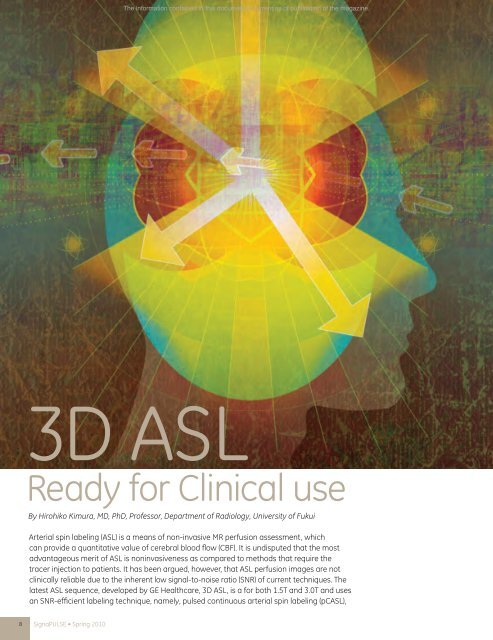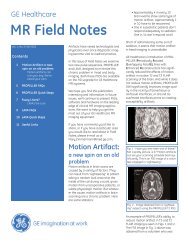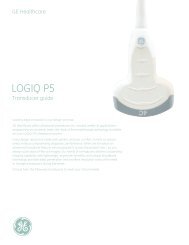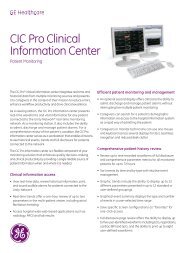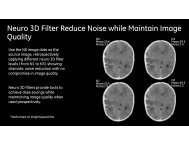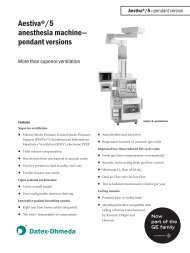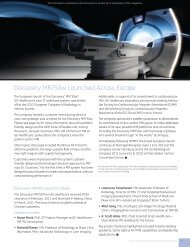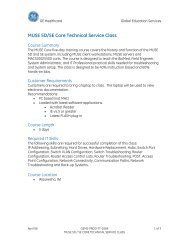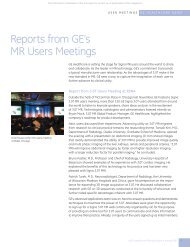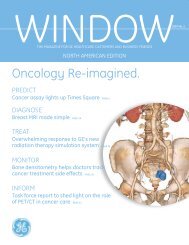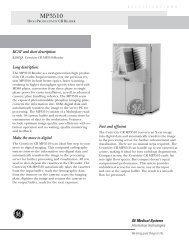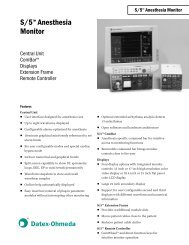Ready for Clinical use - GE Healthcare
Ready for Clinical use - GE Healthcare
Ready for Clinical use - GE Healthcare
You also want an ePaper? Increase the reach of your titles
YUMPU automatically turns print PDFs into web optimized ePapers that Google loves.
The in<strong>for</strong>mation contained in this document is current as of publication of the magazine.<br />
c l i n i c a l v a l u e<br />
N e u r o I m a g i n g<br />
3D ASL<br />
<strong>Ready</strong> <strong>for</strong> <strong>Clinical</strong> <strong>use</strong><br />
By Hirohiko Kimura, MD, PhD, Professor, Department of Radiology, University of Fukui<br />
Arterial spin labeling (ASL) is a means of non-invasive MR perfusion assessment, which<br />
can provide a quantitative value of cerebral blood flow (CBF). It is undisputed that the most<br />
advantageous merit of ASL is noninvasiveness as compared to methods that require the<br />
tracer injection to patients. It has been argued, however, that ASL perfusion images are not<br />
clinically reliable due to the inherent low signal-to-noise ratio (SNR) of current techniques. The<br />
latest ASL sequence, developed by <strong>GE</strong> <strong>Healthcare</strong>, 3D ASL, is a <strong>for</strong> both 1.5T and 3.0T and <strong>use</strong>s<br />
an SNR-efficient labeling technique, namely, pulsed continuous arterial spin labeling (pCASL),<br />
8 SignaPULSE • Spring 2010
The in<strong>for</strong>mation contained in this document is current as of publication of the magazine.<br />
N e u r o I m a g i n g<br />
c l i n i c a l v a l u e<br />
which allows it to be compatible with body coil excitation.<br />
In addition, it <strong>use</strong>s background suppression and a 3D FSE<br />
acquisition to provide robustness to motion and susceptibility<br />
artifacts. The result is whole-brain perfusion coverage with<br />
improved SNR (Figure 1).<br />
Pulsed versus continuous ASL<br />
There are two types of ASL: continuous ASL (CASL) and pulsed<br />
ASL (PASL). In CASL, the blood spins, pass through the labeling<br />
plane are repeatedly inverted to augment the brain perfusion<br />
signal. In PASL, a single pulse is <strong>use</strong>d <strong>for</strong> the labeling, which<br />
usually attains less perfusion contrast than CASL. Although<br />
it is more difficult to implement CASL due to hardware<br />
demands, the perfusion signal is much stronger in CASL than<br />
PASL, making it easier to detect. Since the time between label<br />
and imaging is long in CASL, the perfusion signal is more<br />
homogenously distributed, resulting in the perfusion<br />
signal becoming less sensitive to arterial transit time. 2<br />
Since both PASL and CASL techniques have room <strong>for</strong><br />
improvement, <strong>GE</strong> <strong>Healthcare</strong> has developed a pulsedcontinous<br />
3D ASL technique that provides the excellent<br />
image quality of continuous labeling approaches without<br />
requiring specialized hardware. In addition, since it is 3D,<br />
it is capable of imaging the entire brain in one scan.<br />
Figure 2 demonstrates the comparison of a PASL and pCASL<br />
perfusion imaging technique from the same subject. The<br />
images show an over-estimation of CBF in the occipital<br />
cortex and thalamic regions on PASL maps, likely due to the<br />
delayed arterial transit time resulting in a larger vascular<br />
signal component.<br />
CBF quantification<br />
Quantitative measurement of CBF with 3D ASL signal depends<br />
on the model and its assumption with a number of parameters<br />
including labeling efficiency, cerebral blood volume (CBV),<br />
permeability of blood vessels, blood/brain partition coefficient,<br />
T1 of tissue or arterial blood, and arterial transit time (ATT).<br />
Patients with chronic occlusive cerebrovascular disease<br />
have longer ATT in the affected cortex. This could ca<strong>use</strong><br />
the underestimation of CBF values without ATT correction. 3<br />
CBF and ATT measurements using ASL<br />
in a patient with carotid artery stenosis<br />
The 3D ASL sequence with background suppression was <strong>use</strong>d<br />
<strong>for</strong> perfusion imaging on a Signa HD 3.0T. 1 The acquisitions<br />
with different post-label wait (PW) were also per<strong>for</strong>med<br />
<strong>for</strong> the evaluation of ATT (PW=1.0, 1.5, 2.0, 2.5, 3.0 sec). PD<br />
(TR=2000 ms) and FLAIR (TR/IR=4300/1650 ms) sequences<br />
were also utilized <strong>for</strong> T1 and fully relaxed proton density<br />
images. Both CBF and ATT were calculated in a pixel-bypixel<br />
basis using a two-compartment model. 3<br />
Figure 1. 3D ASL perfusion images of normal brain. 3D ASL prepped 3D FSE<br />
acquired with the total acquisition time of 6 minutes and the section<br />
thickness of 4.5 mm. Total of 35 sections cover the whole brain region<br />
from cerebellum to parietal brain region.<br />
Figure 2. Top row: MR PASL and flow-sensitive alternating inversion recovery<br />
technique (FAIR). Bottom row: pCASL perfusion images from normal brain.<br />
Both FAIR and pCASL were acquired with the total acquisition time of 4 min<br />
and the section thickness of 7 mm. Other parameters of FAIR: TR/TE/TI/<br />
NEX=3000/16/1200/80; pCASL: TR/TE/ PW/NEX=5300/16/1200/46.<br />
A <strong>GE</strong> <strong>Healthcare</strong> MR publication • Spring 2010<br />
9
The in<strong>for</strong>mation contained in this document is current as of publication of the magazine.<br />
c l i n i c a l v a l u e<br />
N e u r o I m a g i n g<br />
A<br />
B<br />
C<br />
Figure 3. CBF maps from a patient with left ICA stenosis. A) ASL without delay compensation,<br />
B) 3D ASL with delay compensation, C) PET-CBF.<br />
Figure 4. Arterial transit map. Same subject as Figure 1. Left cerebral cortical region is clearly<br />
imaged as longer arterial transit time.<br />
Figure 3 shows 3D ASL-CBF maps with and without delay<br />
compensation in a patient with left carotid artery stenosis.<br />
The territory of left MCA is imaged as prominent perfusion<br />
defect with bright vascular signal. However, the slight<br />
hypo-perfusion of the left cortical region is observed in<br />
delay compensated 3D ASL-CBF maps. The left cerebral<br />
cortical lesion is clearly imaged as longer transit time on<br />
ATT maps (Figure 4).<br />
Comparison of 3D ASL with PET<br />
The 3D ASL perfusion values were validated by per<strong>for</strong>ming<br />
a pixel-by-pixel comparison with PET perfusion (Figure 5).<br />
When compared with PET, the correlation of the CBF values<br />
between 3D ASL and PET were significant even with an<br />
altered hemodynamic state. The elongation of arterial<br />
transit time in the affected side was very consistent with the<br />
expected hemodynamics in occlusive cerebrovascular disease.<br />
The results of this study show 3D ASL is clinically applicable<br />
to patients with chronic occlusive cerebrovascular disease<br />
and the large range of hemodynamic conditions present.<br />
<strong>Clinical</strong> application of 3D ASL perfusion imaging<br />
When evaluating central nervous system tumors in a clinical<br />
setting using dynamic susceptibility contrast (DSC) perfusion<br />
imaging, high-tumor blood flow (TBF) or tumor blood volume<br />
(TBV) are the most commonly <strong>use</strong>d criteria <strong>for</strong> high-grade<br />
gliomas. Early reports have shown that both ASL and DSC<br />
perfusion images enabled the distinction of high-grade from<br />
low-grade gliomas with hyper-perf<strong>use</strong>d brain lesions. 4<br />
Moreover, in some cases, ASL produces better contrast than<br />
DSC in the visual demonstration of tumor recurrence via<br />
hyperperfusion. Figure 6 shows both DSC and 3D ASL<br />
perfusion images in a patient with glioma in the left temporal<br />
lobe. The 3D ASL image reveals the hyper-intense perfusion<br />
signal, which is often a characteristic feature of malignant<br />
brain lesions. It is important to note that the foc<strong>use</strong>d lesion<br />
is located in the skull base region, where DSC-EPI is less<br />
reliable due to susceptibility-induced signal loss.<br />
Summary<br />
<strong>GE</strong>’s 3D ASL sequence has successfully demonstrated the<br />
feasibility of continuous ASL-perfusion imaging with ATT<br />
compensation in chronic cerebrovascular disease. The<br />
correlation between the values of 3D ASL CBF and PET-CBF<br />
was significant on the pixel-by-pixel basis comparison. In<br />
a patient with a brain tumor, the 3D ASL signal produces<br />
a better contrast than DSC, even when the foc<strong>use</strong>d area<br />
is located near the skull base region, where DSC is unreliable<br />
due to the susceptibility-induced signal loss inherent<br />
with EPI. •<br />
10 SignaPULSE • Spring 2010
The in<strong>for</strong>mation contained in this document is current as of publication of the magazine.<br />
N e u r o I m a g i n g<br />
c l i n i c a l v a l u e<br />
100<br />
3D ASL-CBF<br />
80<br />
60<br />
40<br />
20<br />
0<br />
0 20 40 60 80 100<br />
PET-CBF<br />
Figure 5. Plot of 3D ASL-CBF and PET-CBF values from a section<br />
through basal ganglia level. The linear regression line is drawn<br />
on the graph.<br />
Dr. Hirohiko Kimura<br />
Hirohiko Kimura, MD, PhD, is a professor at the<br />
Department of Radiology, University of Fukui in<br />
Japan. Dr. Kimura has been extensively published<br />
<strong>for</strong> his ground-breaking work in MR and is<br />
recognized as an MR Thought Leader, 2010.<br />
T1w<br />
A<br />
CBV<br />
B<br />
ASL-CBF<br />
C<br />
Figure 6. The comparison of DSC and 3D ASL perfusion images in a patient with brain<br />
tumor. A) Post Gd-T1 weighted images, B) T2 DSC perfusion images, C) ASL-CBF maps.<br />
Post Gd-T1w reveals the subtle contrast enhacement in the left insular region (arrow<br />
heads). It may be difficult to point out the increase of perfusion signal on T2 DSC<br />
CBV maps. The hyper intensity in the tumor lesion is clearly shown on ASL-CBF<br />
images (arrows).<br />
References:<br />
1. Dai W, Garcia D, de BC, et al. Continuous flow-driven inversion<br />
<strong>for</strong> arterial spin labeling using pulsed radio frequency and<br />
gradient fields. Magn Reson Med 2008;60:1488-97<br />
2. Alsop DC, Detre JA. Reduced transit-time sensitivity in<br />
noninvasive magnetic resonance imaging of human cerebral<br />
blood flow. J Cereb Blood Flow Metab 1996;16:1236-49<br />
3. Kimura H, Kabasawa H, Yonekura Y, et al. Cerebral perfusion<br />
measurements using continuous arterial spin labeling:<br />
accuracy and limits of a quantitative approach. International<br />
Congress Series 2004;1265:238-47<br />
4. Warmuth C, Gunther M, Zimmer C. Quantification of blood<br />
flow in brain tumors: comparison of arterial spin labeling<br />
and dynamic susceptibility-weighted contrast-enhanced<br />
MR imaging. Radiology 2003;228:523-32<br />
A <strong>GE</strong> <strong>Healthcare</strong> MR publication • Spring 2010<br />
11


